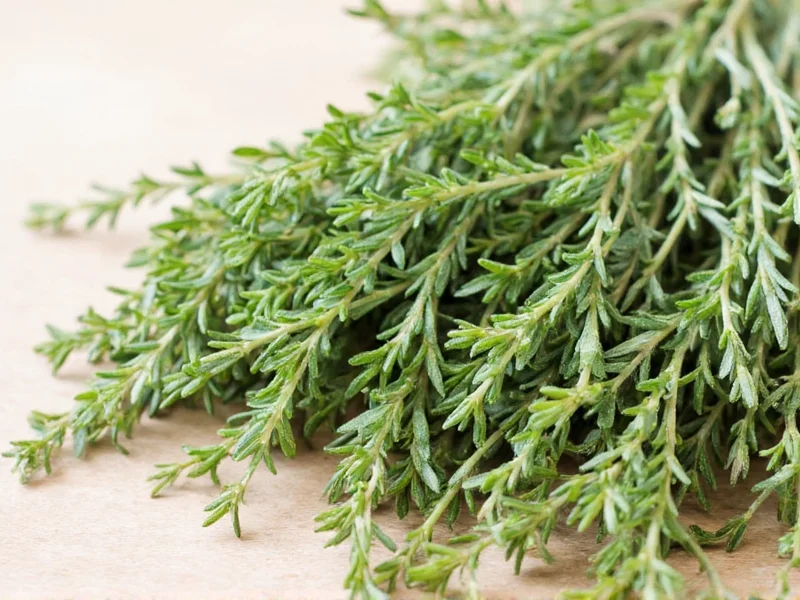Understanding herb conversions is essential for consistent cooking results. When a recipe calls for fresh thyme but you only have dried thyme in your pantry, knowing the precise substitution ratio prevents flavor imbalances in your dishes. The 3:1 fresh-to-dried ratio exists because the drying process removes moisture while concentrating the essential oils and flavor compounds.
Complete Thyme Conversion Guide
Thyme, like most herbs, undergoes significant flavor concentration when dried. This transformation affects both potency and volume. Professional chefs and home cooks alike need accurate measurements to maintain recipe integrity.
| Fresh Thyme | Dried Thyme Equivalent | Best For |
|---|---|---|
| 1 teaspoon | ⅓ teaspoon | Delicate sauces, finishing dishes |
| 1 tablespoon | 1 teaspoon | Standard recipe substitution |
| ¼ cup | 1¼ tablespoons | Stews, braises, long-cooking dishes |
| ½ cup | 2½ tablespoons | Large batch cooking |
| 1 cup | 5 tablespoons | Commercial cooking applications |
Why the 3:1 Ratio Matters in Cooking
Dried thyme contains approximately three times the flavor concentration of fresh thyme. This difference stems from the moisture removal during drying—fresh thyme is about 85% water, while dried thyme contains only 5-10% moisture. The remaining dry matter contains the essential oils responsible for thyme's distinctive flavor.
When substituting, consider these factors:
- Timing matters: Add dried thyme earlier in cooking to allow rehydration and flavor dispersion
- Flavor profile: Dried thyme has a more intense, slightly different flavor profile than fresh
- Recipe type: Delicate dishes require more precise measurements than robust stews
- Quality variation: Dried herb potency varies based on age and storage conditions
Practical Substitution Tips
For best results when converting between fresh and dried thyme:
- Crush dried thyme between your fingers before adding to release essential oils
- When in doubt, start with less dried thyme—you can always add more later
- For recipes with short cooking times, use a 2.5:1 ratio instead of 3:1
- Adjust based on your dried thyme's freshness (older herbs lose potency)
- Consider the dish's final texture—dried thyme won't provide the same visual appeal as fresh sprigs
When Substitution Doesn't Work Well
While the dried-to-fresh thyme conversion works for most cooking applications, certain dishes benefit from using the specifically called-for form:
- Garnishes: Fresh thyme provides visual appeal that dried cannot match
- Cold preparations: Salad dressings and cold sauces don't rehydrate dried thyme properly
- Delicate egg dishes: Omelets and frittatas showcase fresh thyme's subtlety better
- Infused oils: Fresh thyme creates superior flavor extracts
Storage Recommendations for Optimal Flavor
Maximize your thyme's shelf life and flavor potency with proper storage:
Fresh thyme: Store upright in a glass with water (like flowers), covered loosely with a plastic bag in the refrigerator. Use within 10-14 days for best flavor.
Dried thyme: Keep in an airtight container away from light and heat. Properly stored, it maintains good flavor for 1-2 years, though peak potency lasts 6-12 months.
Measuring Techniques for Accuracy
How you measure affects your conversion success:
- For fresh thyme: Strip leaves from stems before measuring
- For dried thyme: Lightly crush in your palm before spooning into measuring spoons
- Never pack dried thyme tightly—it should be loose and fluffy
- Use standardized measuring spoons, not random utensils
Common Thyme Substitution Mistakes to Avoid
Many home cooks make these errors when converting between fresh and dried thyme:
- Using equal volumes (1:1 ratio) resulting in overpowering flavor
- Adding dried thyme too late in cooking, preventing proper flavor release
- Not accounting for dried thyme's age and reduced potency
- Measuring fresh thyme with stems included
- Substituting in dishes where texture matters (like salads)
FAQ: Thyme Conversion Questions Answered
Can I use dried thyme instead of fresh in all recipes?
While you can substitute dried thyme for fresh in most cooked dishes, it's not ideal for cold preparations, garnishes, or delicate dishes where fresh thyme's visual appeal and subtler flavor matter. For cooked dishes, use the 3:1 conversion ratio (1 tablespoon fresh = 1 teaspoon dried).
How do I adjust thyme measurements for older dried thyme?
Older dried thyme loses potency over time. For dried thyme stored more than 6 months, increase the amount by 25-50%. For example, if a recipe calls for 1 teaspoon fresh thyme (requiring ⅓ teaspoon dried), use ½ teaspoon of older dried thyme instead.
Why does dried thyme taste stronger than fresh?
Dried thyme tastes stronger because the drying process removes moisture (about 85% of fresh thyme's weight) while concentrating the essential oils and flavor compounds. This concentration means less dried thyme is needed to achieve similar flavor intensity to fresh thyme.
What's the best way to measure fresh thyme accurately?
For accurate measurement of fresh thyme, strip the leaves from the stems first. Lightly pack the leaves into your measuring spoon without compressing them. One tablespoon of fresh thyme leaves (not including stems) equals approximately 3 grams by weight for precise culinary applications.
Does the conversion ratio differ for other dried herbs?
Yes, while thyme follows the standard 3:1 fresh-to-dried ratio, some herbs differ. Delicate herbs like basil and cilantro use a 3:1 ratio, while more robust herbs like rosemary and oregano often use a 4:1 ratio. Always research specific herb conversions for best results in your recipes.











 浙公网安备
33010002000092号
浙公网安备
33010002000092号 浙B2-20120091-4
浙B2-20120091-4